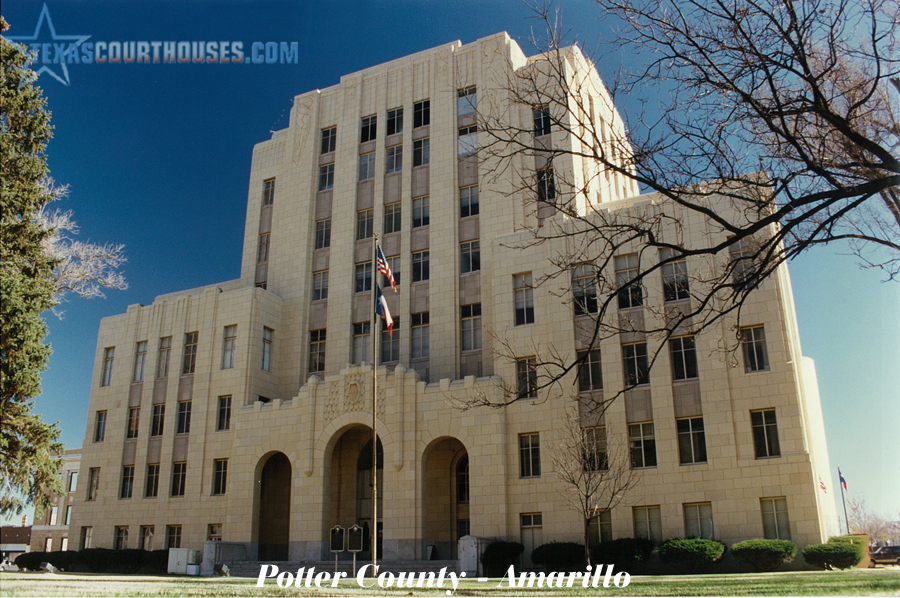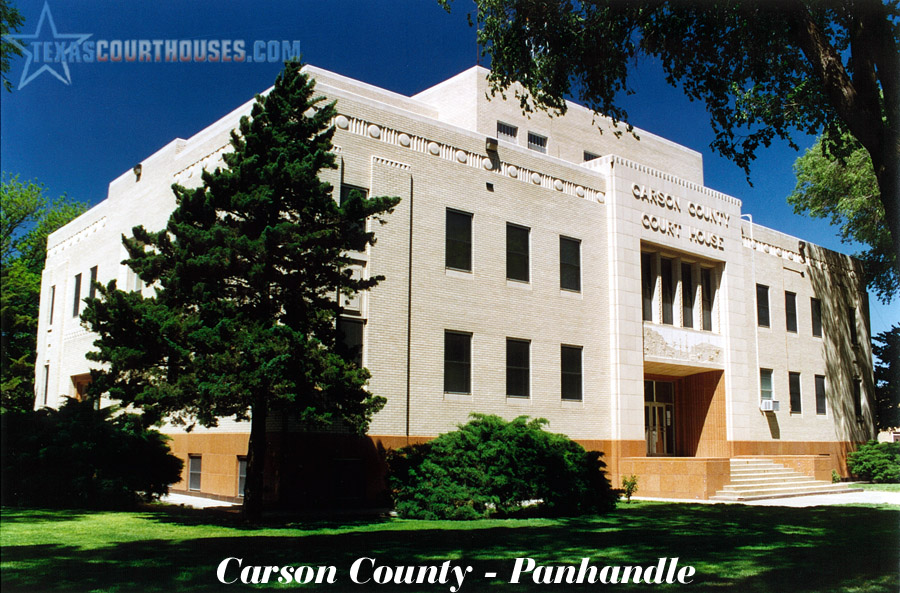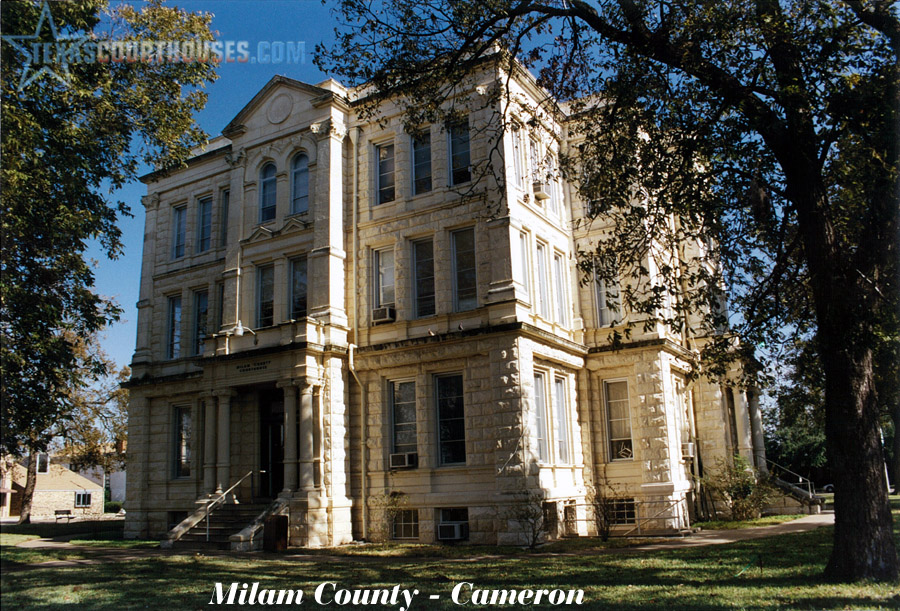1st Courthouse
Building Completion Date: 1887
County Seat: Amarillo
Present Status: Gone
Building Materials/Description: Frame, 40′ x 24′, 2 rooms 15′ x 20′ in back portion of building, clerk in a tent outside, $150
2nd Courthouse
Building Completion Date: 1888
County Seat: Plains Town
Present Status: Gone. Materials used in 1896 courthouse
Architectural Firm: Martin, Byrne & Johnson
Architectural Style: Second Empire
General Contractor: Martin, Byrne & Johnson
Building Materials/Description: Masonry, $66,000 (inc. jail), moved to “New Town”
3rd Courthouse
Building Completion Date: 1896
County Seat: Amarillo
Present Status: Gone
General Contractor: C. H. Black
Building Materials/Description: Masonry, $2538
4th Courthouse
Building Completion Date: 1906
County Seat: Amarillo
Present Status: Gone
Architect: James Edward Flanders
Architectural Style: Classical Revival
General Contractor: J. J. Holt & J. M. Stansberry
Building Materials/Description: Brick, 3-story, 100′ x 65′, fourth story added 1915, $23,000
5th Courthouse
Building Completion Date: 1931
County Seat: Amarillo
Present Status: Existing. Active.
Architect: Towers, Lightfoot & Funk
Architectural: Style Art Deco
General Contractor: C. S. Lambie & Co.,
Building Materials/Description: Concrete, terra cotta
National Register Narrative
Built between 1930 and 1932 at a cost of $315,000, the Art Deco style Potter County Courthouse rises eight stories above the courthouse square in downtown Amarillo. Regionally prominent architect W.C. Townes designed the terra cotta clad building in a stepped configuration more typical of urban skyscrapers during the period. The rectangular building originally housed government offices, court rooms and the county jail facilities. Stylized portrayals of regional motifs such as cattle and cactus grace its main entries and the apex of its tower. This stylized ornamentation complements the simple geometric detailing Townes employed in his earlier design for the Potter County Library, built on the same courthouse block in 1922. Rising above a high basement, this 1-story buff brick building features stylistic references to the Prairie School movement. Prominent as the visual symbols of county government in Amarillo, these buildings retain a high degree of their historic integrity of location, design, setting, materials, workmanship, feeling and association.
The Potter County Courthouse visually dominates the courthouse square from its position at the eastern edge of Block 60 in downtown Amarillo. An extensive lawn dotted with mature elm and juniper trees occupies 210 feet between Taylor Street and the primary (west) facade. The rear (east) entrance provides direct access to Fillmore Street, while secondary entrances on the north and south elevations lead to parking lots. At the southwest corner of the grounds, the Potter County Library building faces Taylor Street. Subordinate objects on the property include a red granite obelisk at the northwest corner of the block, an official Texas Historical Marker adjacent to the primary entrance and a tank from Desert Storm on the southeast lawn.
Symmetrical in composition and massing, this courthouse features four similarly detailed elevations. It takes the form of a diminutive skyscraper, with volumetric blocks stepping back as they rise to a central tower. Transverse wings of four and five stories flank the central tower, creating an H-plan configuration with overall dimensions of 140′ x 80′. The reinforced concrete frame features an exterior veneer of cast-stone. A tripartite arcaded loggia marks the primary entrance on the west facade. Fenestration includes aluminum doors and operable steel casement windows. Uninterrupted piers and stepped massing emphasize the building’s vertical qualities. Ornamental detailing takes the form of bas relief panels above the entry and at the apex of the central tower. These panels portray figures symbolic of the local history and environment. Those above the primary entrance depict flowering cactus, while Native Americans wrapped in blankets, pioneers carrying rifles, and local vegetation and wildlife grace the apex of the tower. A single ply membrane roof covers the building.
The interior of the arcaded entry incorporates a Texas longhorn steer medallion cast from aluminum. Elongated light fixtures hang over the entrance. Original doors and hardware remain throughout the building. Some interior spaces survive, as does most of the original marble wainscotting. Two courtrooms on the fourth floor are intact, including one restored as a courtroom for visiting judges.
Facing west from the southwest corner of the same block, the 1922 Potter County Library building incorporates a single story above a raised basement. Local architects J. Roy Smith and W.C. Townes designed the buff brick building with simple geometric detailing popularized by the Prairie School movement combined with an austere classicism popular in the 1920s. An expansive entrance with an angular stairway provides the focal point of the symmetrical primary (west) facade. Flanking banks of double-hung windows feature transoms with decorative mullions. A corbeled brick belt course and a cast stone cornice provide a note of austere classicism to the composition. Other cast-stone detailing includes window sills and stylized hood moldings, as well as coping for the stepped parapet. This parapet hides a flat asphalt roof. Similar detailing graces the sides and rear of the building, although prominent chimneys provide the focal point for each of the side elevations. Arched entries cut into the mass of the fireplaces to provide access to the basement on these elevations.
Block 60 of the Glidden & Sanborn Addition in Amarillo historically served as the focal point of county government in this Texas Panhandle community. Increasing demands for governmental services prompted by the oil boom of the 1920s moved the Potter County Commissioner’s Court to authorize construction of two new buildings on the block during this period. Regionally prominent architect W.C. Townes designed the first in 1922 to house the Potter County Library. Townes also played a significant role in the subsequent design for a new county courthouse and jail facility on the same property. Financed by a bond election in 1930 and formally dedicated in 1932, this Art Deco building stands out among numerous similar commissions throughout the Texas Panhandle and eastern New Mexico. In continuous service as county offices since their construction, these buildings represent the economic development, cultural aspirations and political history of this county seat. As a result, the property is nominated at the local level of significance under Criterion A in the areas of Politics/Government and Social History and under Criterion C in the area of Architecture.
Organized on 30 August 1887 in response to construction of the Fort Worth and Denver City rail line, Potter County initially established its seat at a site promoted by J.C. Berry and Company of Abilene, Texas. Held on 26 September 1887, the first commissioner’s court session ordered construction of a temporary frame courthouse in the new community of Amarillo. They accepted a bid of $191 submitted by the partnership of Mays, Hightower and Jackson. Within a year, however, they commissioned Martin, Bryan and Johnson to build a brick court house on the courthouse square bounded by Bowie ,Travis, Fourth and Fifth streets. The building’s completion in May 1889 coincided with unusually heavy rains that flooded the new community and prompted property owners to move their homes and business to higher, dryer ground. This mass relocation to the Glidden and Sanborn Addition one mile to the east fulfilled the aspirations of Henry Sanborn, a barbed wire salesman and promoter whose earlier efforts to locate the town on his land met with little success.
County law barred relocation of the courthouse within five years of its construction, so the facility in the original town site remained the seat of county government throughout this early period in Amarillo’s history (McCallum: 1965). The commissioner’s court nevertheless rented offices in the new town to facilitate provision of county services. Clerks carried records back and forth as needed. This awkward situation attracted the attention of the St. Louis Democrat, which sent a reporter to cover the story of the community that moved away from its courthouse(Crudgington: 1957).
This state of affairs prompted petitions calling for the relocation of the courthouse to the Glidden and Sanborn Addition. In 1896 the county commissioners acquiesced, purchasing a lot at Fifth and Taylor streets. They accepted the bid of C.H. Black to dismantle the old court house and rebuild it on the new site just west of Block 60, the officially designated public square in the Glidden and Sanborn Addition. Sanborn’s refusal to allow so small a facility to occupy the tract resulted in Block 60 remaining vacant for another decade.
By 1903 the inadequacy of this facility led to controversial efforts to build a larger courthouse. County Judge Lon Marrs led a bitter fight to authorize a bond issue to finance construction of a new courthouse and a jail centered in Block 60. Voters approved a $50,000 bond issue despite claims that the new buildings were too big and costly. Although Marrs ultimately lost his own bid to get reelected as a result of the controversy, the commissioner’s court hired J.J. Holt to construct two native stone buildings with classical detailing. Completed in April 1906, the buildings featured horizontal bands of rusticated stone. A fourth floor was added to the courthouse in 1915.
During this period Amarillo evolved as the focus of regional markets for agricultural, livestock, commercial and petroleum interests. The Atchison, Topeka and Santa Fe Railway network established the community as the hub of a trading area that embraced the Texas Panhandle and neighboring parts of Oklahoma, Kansas, Colorado and New Mexico. Regional discoveries of oil and natural gas fueled a period of widespread economic expansion and rampant population growth which in turn fostered unprecedented demands for governmental services.
Among the county’s responses was authorization of a new building on Block 60 to house a free library for local citizens and facilities for travelers through Amarillo. The concept for the building arose from the vision of 12 young women of the J.U.G. (Just Us Girls) club. In 1902 the club decided to devote themselves to library work under the direction of Mrs. J.H. Willis, rather than pursue strictly social goals. Willis and her husband donated a lot and secured a house to be relocated onto the lot as a free public library. The women opened the library with donated books and funds raised through bazaars, candy sales, and membership fees of $1.50. By 1907 other women’s clubs were assisting operation of the library, which quickly outgrew the initial facilities. Local businessmen donated funds to cover rent in a series of locales including rooms over the old post office, a hall over the fire station, and finally rooms at the city hall. The women’s clubs initially paid the salary of Elizabeth Doris, the first librarian, until the Board of City Development assumed the responsibility. In 1915 the library board unsuccessfully sought a $40,000 Carnegie grant to sustain the establishment when city officials balked at raising taxes to support the library.
Determined that the library should be a public institution despite these setbacks, the library board turned to the county for support. In response, the commissioner’s court authorized establishment of a county library in July 1921, commissioning local architects J. Roy Smith and W.C. Townes to design the building. Established after the Dallam County Library (April 1920), the Cooke County Free Library (July 1920), and the Harris County Free Library (May 1921) as the fourth county library in Texas, the Potter County Library opened on 22 June 1922 as the only such facility with its own building (Amarillo Daily News, 11 May 1924).
At the behest of Judge Ray C. Johnson, Townes incorporated public lounge facilities into the basement of the library building. Judge Johnson publicly called attention to the need for a facility allowing women and small children to refresh themselves while downtown (Amarillo Daily News, 17 September 1921). With support from the Potter County Federation of Women’s Clubs, plans emerged to accommodate shoppers and tourists at the public library building. Mrs. Samuel Worth, described as a good Christian woman, served as matron at the opening of these public lounge facilities in July 1922 (Amarillo Daily News, 1 July 1922). Possessing a wide knowledge of the city, Worth also gave directions to tourists and rendered First Aid assistance. Her realm included an assembly hall, a living room, a lunch room and a resting room with beds for napping babies and women. Anna Bauer, county home demonstrator, also maintained an office in the basement to assist women with homemaking advice.
Within a few short years, the pace of economic expansion in the region again prompted discussion of the need for new county facilities to handle the increased demand for governmental services. Large oil strikes in 1925 fostered a frenzied period of economic expansion in the region, with dozens of oil companies establishing their headquarters in Amarillo. During the first quarter of 1926 alone almost 400 building permits were issued to accommodate the demand for offices, residences and services required by business travelers, oil workers, and others pouring into the community. While Amarillo’s tallest building prior to this period rose only four stories, eight new skyscrapers transformed the cityscape after 1925.
In response, boosters began promoting construction of a courthouse and jail commensurate with Amarillo’s new status as the metropolis of the Panhandle. Fiscal conservatives proposed remodeling the old courthouse, but county judge Sam B. Motlaw and the commissioner’s court supported construction of new facilities. A successful $420,000 bond election on 31 August 1930 enabled the commissioner’s court to authorize construction of a new building to house both courthouse and jail functions. Plans called for the new building to face west from the east side of Block 60. This placement allowed courthouse operations to continue in the old buildings until completion of the new facility. Former county judge J.W. Crudgington proposed selling the west half of the block for about $800,000 to reduce the indebtedness of the county following demolition of the old courthouse and jail buildings. “What is a courthouse square, anyway,” he asked, “except a sitting ground for loafers? Did anybody ever see a courthouse square that was a beauty spot?” (Amarillo Daily News, 30 January 1930). County commissioners overrode this approach, however, approving plans to establish a park setting on the western half of the block. This option also protected the county’s recent investment in the Potter County Library building.
Proponents of the new construction project portrayed it as a way to ameliorate the effects of the Depression. County commissioners, for example, structured contracts for the project to ensure employment of local workers and provision of supplies by Amarillo firms. The commissioner’s court hired the local architectural firm of Townes, Lightfoot and Funk to design the new facility. In a similar move, they awarded Amarillo builder Charles S. Lambie (1880- 1966) both the contract to raze the old buildings and the contract to construct the new courthouse at a cost of $315,000. They stipulated that he hire only local laborers at a salary of 40 cents an hour. A front page newspaper story reported that more than 500 laborers, all heads of families and residents of the county, applied for work on the project. County residence for one year was required before a job application was accepted (Amarillo Globe, 18 December 1930). Local firms were awarded all bids for the project, with the exception of specialty equipment provided by the Busby Electric Company of Dallas (electrical wiring), the Southern Prison Company of San Antonio (jail equipment), Otis Elevator and Southwestern Bell Telephone Company. Page Brothers of Austin, well known for their courthouse and jail projects throughout the state, served as consulting architects jail equipment installation for the new facility.
His previous work on the Potter County Library made William C. Townes (1883-1961) the logical choice to head up the new courthouse project. Born in Haskell, Texas, Townes arrived in Amarillo as a carpenter in 1905. He studied at home for his architectural degree, finding work with the Santa Fe Railway during World War I. He initially partnered with J. Roy Smith in the architectural firm of Smith & Townes between 1920 and 1924. By 1927 he formed the partnership of Townes, Lightfoot & Funk. The successor firm of Townes & Funk dissolved upon the death of Rabey Funk in 1939 and Townes practiced solo for the rest of his life. In addition to Potter County’s courthouse, Townes designed six more courthouses still in use in Briscoe, Castro, Childress, Dallam (1923; NR 1992), Hutchinson and Ward counties in Texas. He specialized in courthouses; reportedly designing a total of 27 in Texas and eastern New Mexico (Breeze: 1990). He also designed many residences in Amarillo including the the Jons-Danner House (with W.F. Janzen; 1907; NR 1992) and others throughout the Plemons and Mrs. M.D. Oliver-Eakle neighborhoods (NR 1992). In addition to the courthouse and library (with J. Roy Smith) commissions from the county, his institutional designs in Amarillo included the Municipal Auditorium (demolished), the Hilltop School, the Will Rogers School and the Lucerne Apartments. He also designed elementary and high schools in Canyon, Phillips, Pampa, Dimmitt, Follett and other Panhandle cities.
Support from county judge Sam B. Motlow proved instrumental to the success of Townes’ design for the new courthouse. A progressive leader, Judge Motlow also campaigned for road improvement projectss and the establishment of facilities for tourists. County Commissioners W.W. Lynch, Carl Hill, M.L. Parker, and C.E. Weymouth joined him in attending ground breaking ceremonies on 18 December 1930. The building was ready for occupancy on 18 January 1932, when hundreds of Potter County citizens crowded into their new courthouse for public inspection tours. ROTC cadets and Shriners served as guides while the Amarillo College of Music Junior Band and the Khiva Chanters Orchestra gave concerts. The judge and commissioners occupied offices on the first floor. Sheriff W.N. Thompson also occupied ground floor space along with the two justices of peace and the constable. A secure elevator conveyed prisoners from the sheriff’s department to the jail floors in the tower. The second floor housed county records, with floors three to six providing courtroom facilities. The new courthouse also housed a jury dormitory
Functions of Potter County government remained in the buildings on Block 40 throughout the period of significance. The Potter County Library building continued to serve as county offices after its initial functions ceased. By 1940 the city assumed control of the library, initially moving the collection into the Municipal Auditorium and subsequently to the Mary Elizabeth Bivins House (1904; NR 1974) in 1955. With the decline in tourist traffic prompted by the onset of World War II basement, the basement of the library building served as a meeting facility, while the U.S. Selective Service operated out of the original library space during this period. After the war, the main floor of the library building housed the Potter County Judge’s office and the Potter County Commissioner’s Court. The building now contains offices for the Potter County Probation Department. Expansion of other county offices resulted in adaptation of commercial buildings across Sixth Avenue into facilities for the county tax department and a central jury room. In 1986 the commissioner’s court authorized construction of a new courts building and central jury room to the east across Fillmore Street. Court orders requiring construction of a new jail building to meet current jail standards resulted in the abandonment of the jail floors and their subsequent conversion to storage facilities in May 1988. Other space for county offices was secured with the purchase of the vacant 14-story Santa Fe Building in 1995. None of these alternatives resulted in irreversible exterior changes to the historic buildings on Block 60.
The Potter County Courthouse is significant under Criterion C in the area of Architecture as one of the best Art Deco courthouses in Texas. It is the centerpiece of downtown Amarillo with its full block setting of grass and trees. Virtually unaltered, it is also among the best examples of the style in Amarillo. Other extant examples include the old Paramount Theater (1932) at 817 South Polk Street, converted into an office and parking building, the White & Kirk Building (1938) at 516 South Polk, insensitively altered in recent years, and the S.H. Kress Building (1932) at 700 Polk. In addition, the courthouse is eligible under Criterion A in the area of Politics/Government as the seat of county government for more than half a decade. The adjacent Potter County Library is also eligible under Criterion A in the area of Social History for its significant role as an early public library and tourism facility. It is further significant under Criterion C in the area of Architecture as a distinctive public building of the 1920s. Together these buildings represent the economic development, cultural aspirations and political history of this county seat throughout the early 20th century.



